标签:aci ima 定义 格式化 打印 content 异常 main current
概述:
是jdk提供的,只有一个后台线程,可以对多个任务定时定频率的调度。
主要构件:
Timer和TimerTask,Timer定时调用TimerTask来对任务定时调度。
import java.util.TimerTask;
public class MyTimerTask extends TimerTask{
private String name;
public MyTimerTask(String inputName) {
this.name = inputName;
}
@Override
public void run() {
// 打印当前的name的内容
System.out.println("current name is:"+name);
}
public String getName() {
return name;
}
public void setName(String name) {
this.name = name;
}
}import java.util.Timer;
public class MyTimer{
public static void main(String[] args) {
//1.创建一个timer实例
Timer timer=new Timer();
//2.创建一个MyTimerTask实例
MyTimerTask myTimerTask=new MyTimerTask("NO.1");
//3.通过Etimer定时定频率调用myTimerTask的业务逻辑
//即第一一次执行是在当前时间的两秒之后,之后每隔一秒钟执行一次
timer.schedule(myTimerTask, 2000L,1000L);//执行的任务,第一次执行间隔,循环间隔
}
}task:所要安排的任务time:执行任务的时间?实战
import java.text.SimpleDateFormat;
import java.util.Calendar;
import java.util.TimerTask;
public class MyTimerTask extends TimerTask{
private String name;
public MyTimerTask(String inputName) {
this.name = inputName;
}
@Override
public void run() {
//以yyyy-MM-ddHH:mm:SS的格式打印当前执行时间
//如2016一11一11 00:00:00
Calendar calendar=Calendar.getInstance();//当前时间
SimpleDateFormat sf=new SimpleDateFormat("yyyy-MM-ddHH:mm:ss");
System.out.println("current exec time is:"+sf.format(calendar.getTime()));
////打印当前name的内容
System.out.println("current exec name is:"+name);
}
public String getName() {
return name;
}
public void setName(String name) {
this.name = name;
}
}import java.text.SimpleDateFormat;
import java.util.Calendar;
import java.util.Timer;
public class MyTimer{
public static void main(String[] args) {
//1.创建一个timer实例
Timer timer=new Timer();
//2.创建一个MyTimerTask实例
MyTimerTask myTimerTask=new MyTimerTask("NO.1");
/**
* 获取当前时间,并设置成距离当前时间三秒之后的时间
*如当前时间是2016一11一10 23:59:57
则设置后的时间则为2016一11一11 00:00:00
*/
Calendar calendar=Calendar.getInstance();
SimpleDateFormat sf=new SimpleDateFormat("yyyy-MM-ddHH:mm:ss");
System.out.println(sf.format(calendar.getTime()));
calendar.add(calendar.SECOND, 3);//添加3s
/**
*1.在时间等于或超过time的时候执行且仅执行一次task
如在2016一11一11 00:00:00执行一次task:打印任务的名字
*/
myTimerTask.setName("schedule1");
timer.schedule(myTimerTask, calendar.getTime());//这个calendar是3s后的
}
}
task:所要安排的任务time:首次执行任务的时间period:执行一次task的时间间隔,ms?实战
myTimerTask.setName("schedule2");
//这个calendar是3s后的
//3s之后第一次执行,之后,每隔2s执行一次
timer.schedule(myTimerTask, calendar.getTime(),2000L);
task:所要安排的任务delay:执行任务前的延迟时间,单位是ms? 实战
myTimerTask.setName("schedule3");
//1s之后执行这个任务
timer.schedule(myTimerTask, 1000);
task:所要安排的任务delay:执行任务前的延迟时间,单位是msperiod:执行任务的间隔,单位是ms?实战
myTimerTask.setName("schedule4");
//3s之后执行这个任务,之后每隔2s执行一次
timer.schedule(myTimerTask, 3000,2000);
task:所要安排的任务time:首次执行任务的具体时间period:执行时间间隔,ms?实战
myTimerTask.setName("scheduleAtFixedRate1");
//在calendar的时候,首次执行;之后,每隔2s执行一次
timer.scheduleAtFixedRate(myTimerTask, calendar.getTime(), 2000);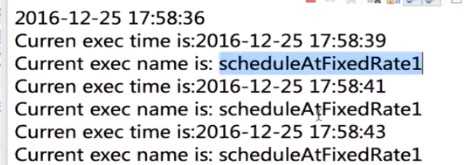
task:所要安排的任务delay:执行任务前的延迟时间,单位是msperiod:执行时间间隔,ms myTimerTask.setName("scheduleAtFixedRate2");
//在3s后,首次执行;之后,每隔2s执行一次
timer.scheduleAtFixedRate(myTimerTask, 3000, 2000);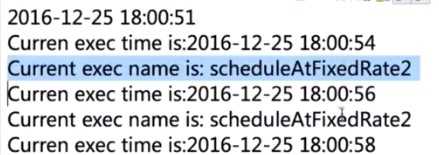
?实战
import java.text.SimpleDateFormat;
import java.util.Calendar;
import java.util.TimerTask;
public class MyTimerTask extends TimerTask{
private String name;//任务名
private Integer count=0;//计时器
public MyTimerTask(String inputName) {
this.name = inputName;
}
@Override
public void run() {
if (count<3) {
//以yyyy-MM-ddHH:mm:SS的格式打印当前执行时间
//如2016一11一1100:00℃0
Calendar calendar=Calendar.getInstance();
SimpleDateFormat sf=new SimpleDateFormat("yyyy-MM-ddHH:mm:ss");
System.out.println("current exec time is:"+sf.format(calendar.getTime()));
////打印当前name的内容
System.out.println("current exec name is:"+name);
count++;//每次任务,数+1
}else {
cancel();//超过三次,取消任务
System.out.println("Task cancel!");
}
}
public String getName() {
return name;
}
public void setName(String name) {
this.name = name;
}
} myTimerTask.setName("schedule4");
//3s之后执行这个任务,之后每隔2s执行一次
timer.schedule(myTimerTask, 3000,2000);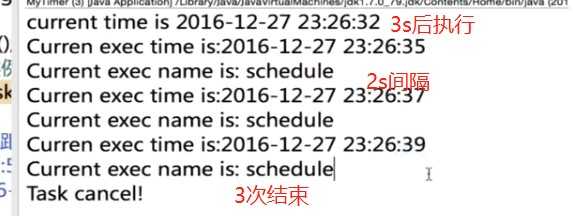
?实战
timer.schedule(myTimerTask, 3000);
System.out.println("scheduled time is:"+sf.format(myTimerTask.scheduledExecutionTime()));//返回的是刚运行完的任务的运行时间
所有当前已安排的任务(Timer下是所有的任务)?实战
import java.text.SimpleDateFormat;
import java.util.Date;
import java.util.Timer;
public class CancelTest{
public static void main(String[] args) throws InterruptedException {
//1.创建一个timer实例
Timer timer=new Timer();
//2.创建TimerTask实例
MyTimerTask task1=new MyTimerTask("task1");
MyTimerTask task2=new MyTimerTask("task2");
Date startTime=new Date();
SimpleDateFormat sf=new SimpleDateFormat("yyyy-MM-ddHH:mm:ss");
System.out.println(sf.format(startTime));//当前时间
//taskl首次执行是距湍现在时间3秒后执行,之后每隔2秒执行一次;
//task2首次执行是距离现在时间1秒后执行,之后每隔2秒执行一次
timer.schedule(task1,3000,2000);
timer.schedule(task2,1000,2000);
//休眠5秒
Thread.sleep(5000);
//获取当前的执行时间并打印
Date cancelTime=new Date();
System.out.println("cancel time is:"+sf.format(cancelTime));
//取消所有任务
timer.cancel();
System.out.println("Tasks all cancled!");
}
}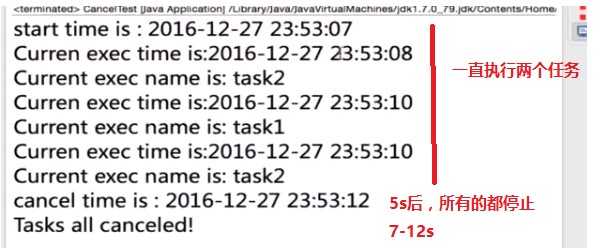
已取消的任务?实战
public class CancelTest{
public static void main(String[] args) throws InterruptedException {
//1.创建一个timer实例
Timer timer=new Timer();
//2.创建TimerTask实例
MyTimerTask task1=new MyTimerTask("task1");
MyTimerTask task2=new MyTimerTask("task2");
Date startTime=new Date();
SimpleDateFormat sf=new SimpleDateFormat("yyyy-MM-ddHH:mm:ss");
System.out.println(sf.format(startTime));//当前时间
//taskl首次执行是距湍现在时间3秒后执行,之后每隔2秒执行一次;
//task2首次执行是距离现在时间1秒后执行,之后每隔2秒执行一次
timer.schedule(task1,3000,2000);
timer.schedule(task2,1000,2000);
//当前已取消的任务数
System.out.println("current cancleld task number is:"+timer.purge());
//休眠5秒
Thread.sleep(2000);
//获取当前的执行时间并打印
Date cancelTime=new Date();
System.out.println("cancel time is:"+sf.format(cancelTime));
//取消task2任务(2s后,取消task2)
task2.cancel();
System.out.println("current cancleld task number is:"+timer.purge());
}
}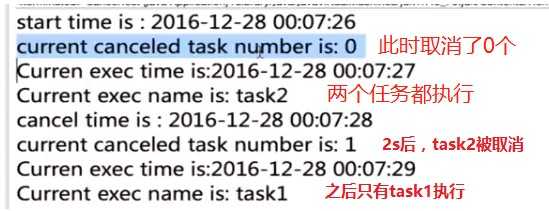
定义的时间已将过去了;
1.schedule
"fixed-delay";如果第一次执行时间被delay了,随后的执行时间按照上一次实际执行完成的时间点进行计算;
public class DifferenceTest{
public static void main(String[] args) {
final SimpleDateFormat sf=new SimpleDateFormat("yyyy-MM-ddHH:mm:ss");
Calendar calendar=Calendar.getInstance();
System.out.println("Current time is"+sf.format(calendar.getTime()));
//设置成6秒前的时旬,若当前时间为2016-12-28 00:00:06,
//那么设置之后时间变成2016-12-28 00:00:00
calendar.add(Calendar.SECOND,-6);
Timer timer=new Timer();
//第一次执行时间为6秒前,之后每隔两秒钟执行一次
timer.schedule的时候,开始时间是现在就开始(new TimerTask() {
@Override
public void run() {
//打印任务执行时间
System.out.println("Schedyle exec time is:"+sf.format(scheduledExecutionTime()));
System.out.println("Task is being executed!");
}
}, calendar.getTime(), 2000);
}
}
尽管设置的开始时间是6s前,但是用schedule的时候,开始时间是现在就开始
2.scheduleAtFixedRate方法
"fixed-rate";如果第一次执行时间被delay了,随后的执行时间按照上一次开始的时间点进行计算,并且为了赶上进度会多次执行任务,因此TimerTask中的执行体需要考虑同步.
timer.scheduleAtFixedRate(new TimerTask() {//只是换了一下方法名
@Override
public void run() {
//打印任务执行时间
System.out.println("Schedyle exec time is:"+sf.format(scheduledExecutionTime()));
System.out.println("Task is being executed!");
}
}, calendar.getTime(), 2000);-结果:

会将之前落下的任务补上,然后继续执行;
任务2s,间隔1s,任务还没有执行完,就要进行下一次了
1.schedule
下一次执行时间相对于上一次实际执行完成的时间点,因此执行
时间会不断延后
timer.schedule(new TimerTask() {//scheduleAtFixedRate
@Override
public void run() {
try {
Thread.sleep(3000);
} catch (InterruptedException e) {
e.printStackTrace();
}
//打印任务执行时间
System.out.println("Schedyle exec time is:"+sf.format(scheduledExecutionTime()));
System.out.println("Task is being executed!");
}
}, calendar.getTime(), 2000);
上一个任务执行完才执行
2.scheduleAtFixedRate方法
下一次执行时间相对于上一次开始的时间点,因此执行时间一般
不会延后,因此存在并发性;
---不会延后,会直接运行任务;
timer.scheduleAtFixedRate(new TimerTask() {
@Override
public void run() {
try {
Thread.sleep(3000);
} catch (InterruptedException e) {
e.printStackTrace();
}
//打印任务执行时间
System.out.println("Schedyle exec time is:"+sf.format(scheduledExecutionTime()));
System.out.println("Task is being executed!");
}
}, calendar.getTime(), 2000);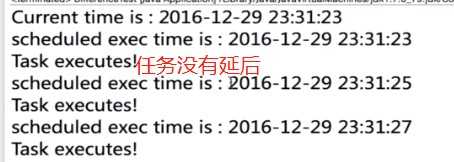
隔两秒打印最近一次计划的时间、执行内容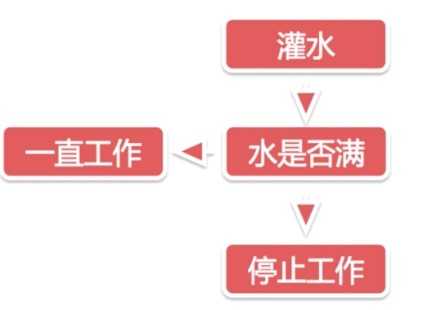
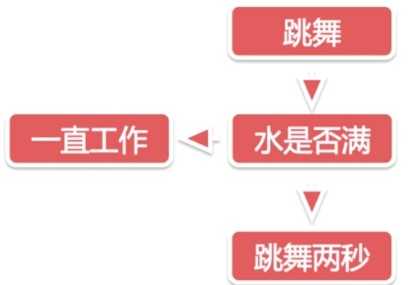
public class DancingRobot extends TimerTask{
@Override
public void run() {
//获取最近的一次任务执行的时间,并将其格式化
SimpleDateFormat sf=new SimpleDateFormat("yyyy-MM-ddHH:mm:ss");
System.out.println("Scheduled exec time is:"
+sf.format(scheduledExecutionTime()));
System.out.println("Dancing happily!");
}
}public class WaterRobot extends TimerTask{
//最大容量为5L
private Integer bucketCapacity=0;
@Override
@Override
public void run() {
//灌水直至桶满为止
if(bucketCapacity<5){
System.out.println("Add 1L water into the bucket!");
bucketCapacity++;
}else {
//水满之后就停止执行
System.out.println("The number of canceled task in timer is:"+timer.purge());//已取消的任务数
cancel();
System.out.println("The WaterRobot has bean aborted");
System.out.println("The number of canceled task in timer is:"+timer.purge());//已取消的任务数
System.out.println("current water is:"+bucketCapacity+"L");//已取消的任务数
//等待2s钟,终止timer的所有任务(2s后,停止跳舞机器人)
try {
Thread.sleep(2000);
} catch (InterruptedException e) {
e.printStackTrace();
}
timer.cancel();
}
}
}public class Executor{
public static void main(String[] args) {
Timer timer=new Timer();
Calendar calendar=Calendar.getInstance();
SimpleDateFormat sf=new SimpleDateFormat("yyyy-MM-ddHH:mm:ss");
System.out.println(sf.format(calendar.getTime()));
DancingRobot dancingRobot=new DancingRobot();
WaterRobot waterRobot=new WaterRobot(timer);
timer.schedule(dancingRobot,calendar.getTime(),2000);
timer.scheduleAtFixedRate(waterRobot, calendar.getTime(), 1000);
}
}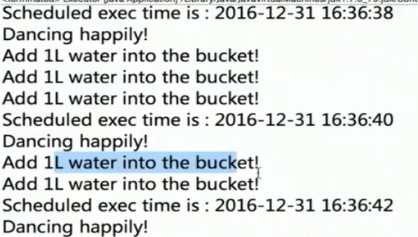

Timer有且仅有一个线程去执行定时任务,如果存在多任务,且任务时间过长,会导致执行效果与预期不符
只有一个线程,在定义的时候同时进行的任务实际上不能同时执行
如果TimerTask抛出RuntimeException,Timer会停止所有任务的运行


















标签:aci ima 定义 格式化 打印 content 异常 main current
原文地址:https://www.cnblogs.com/ziyue7575/p/12538977.html